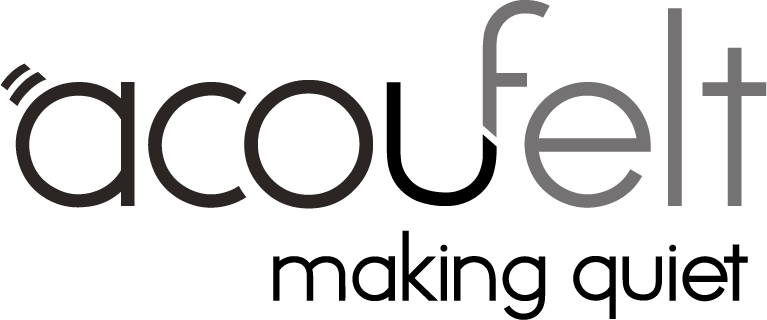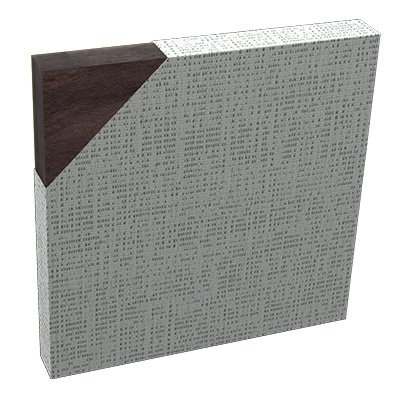Andy’s Guide: Specifying Fabric-Wrapped Panels
In the world of construction materials, noise control is quickly growing into one of the more nuanced specialty product lines in the industry.
Even the most basic and antiquated acoustic products – Fabric Wrapped Fiberglass Panels - carry with them a wide variety of composite constructions with their own host of benefits and use cases. This guide is meant to help architects and interior designers specify the right fabric wrapped panel for each unique condition. Let’s get started!
Staples
When it comes to treating a space for reverberation or high DB levels, we generally start at a 1” thick or greater panel. The thicker the panel, the more absorption you will achieve (especially in the lower frequencies), but we also want to be careful to not over treat a space. Its always best to collaborate with Gaus Acoustics or your Acoustic Engineer when specifying acoustic treatment to ensure you’re hitting the precise absorption level needed to achieve your ideal soundscape.
Every manufacturer has their tried-and-true standard fabric wrapped panel. Ours is the Gaus Acoustic Jericho 2000 wall panel. This product is likely what most people think of when they hear the word “acoustical panel”.
Coming in ½”, 1” 1-1/2”, and 2” thicknesses, these panels are made of compressed fiberglass with chemically hardened edges, then are wrapped in acoustically transparent fabric for a clean finish. These are easily cleanable, and easy to install, but best suited for areas out of daily traffic due to their fragile nature.
Great For: Sound Absorption in Corporate environments, healthcare spaces, theaters, and media rooms where exposure to traffic and abuse are low.
Not Great For: Sound Blocking, and Sound Diffusion. Not ideal for installation in Gymnasiums, Educational environments, or heavily trafficked areas.
Where to Install: High up on walls or direct applied to ceilings.
Aesthetic Variations of The Baseline
When the traditional fabric-wrapped aesthetic just won’t do, specifying an Inspire Art Printed panel or Chroma Paintable Panel is an excellent choice.
Inspire Art Printed Panels come with a stretch fabric that is acoustically transparent but offers limitless printing capabilities. While the panels max out at 4’x8’, the printed image can be continued across multiple panels to achieve a seamless custom aesthetic.
Chroma Paintable panels come with a fabric that is made to emulate the look of drywall, and can be painted any Sherwin Williams color code with their patented acoustically transparent paint. Chroma panels can be painted in the field or in the factory, but require a specific painting method to protect its acoustic integrity.
Great For: Sound Absorption where aesthetic is the primary focus. Creating logo walls, inspirational images, branding, or achieving a drywall look without sacrificing sound absorption.
Not Great For: Sound Blocking, and Sound Diffusion. Not ideal for installation in high traffic areas where abuse is likely.
Where to Install: Anywhere on the walls in low-traffic areas, high up on walls in high-traffic areas, or direct applied or suspended from the ceiling.
Adding Durability
While the baseline acoustical panel has its place, that place unfortunately is not universal. In areas that are heavily trafficked, they can lose their shape from repeated contact. The Jericho 2100HI is the answer to that problem.
Built with a PCF High Impact Fiberglass facing, the high impact acoustical wall panel absorbs sound and keeps its shape in classrooms, hallways, and anywhere within reach of daily occupants, but is still susceptible to damage if faced with consistently heavy abuse.
To battle that issue in places like municipal facilities, gymnasiums, fitness room, and public spaces where repeated heavy impact is likely, the Jericho 4000HA and S4100E add a perforated co-polymer underlayment to the composite construction for extreme resilience in all conditions.
Great For: Sound Absorption in classrooms, gymnasiums, fitness centers, municipal facilities, and highly trafficked areas.
Not Great For: Sound Blocking, and Sound Diffusion. Could be extraneous in corporate environments recording studios or media rooms.
Where to Install: All wall and ceiling surfaces
Addressing Sustainability Goals
BioCore panels use an ECOSE core made of formaldehyde-free binder technology, as opposed to the petro-based chemicals that are traditionally used in fiberglass. While still offering all the sound absorbing performance of traditional J-Wall 2000 panels, as well as the fabric wrappings, BioCore panels are only slightly more expensive and offer Green Guard Gold Certification and LEED eligibility.
BioCore panels can be used anywhere that the traditional S-2000 panels are recommended: above traffic height, or in any space where consistent abuse is expected to be held to a minimum.
Great For: Sound Absorption Hitting sustainability goals (LEED and WELL certified). Both spot coverage and comprehensive coverage. Areas above traffic height, or spaces that will not receive any abuse – conference rooms, corporate offices, etc.
Not Great For: Sound Diffusion or Sound Blocking. Not ideal for installation in Gymnasiums, Educational environments, or heavily trafficked areas.
Where to Install: High up on walls or direct applied to ceilings.
Addressing Sound Transmission Between Rooms
While the S-2000 and high impact panels are made primarily to absorb sound within a space, they do very little to stop sound from travelling from one space to another. This phenomenon is called sound transmission, and can be very difficult to treat after walls, floors and ceilings are built.
The S-2500 panel addresses this issue by adding a layer of mass loaded vinyl sandwiched between two layers of sound absorbing fiberglass board. These panels must be applied from floor to ceiling across an entire wall surface to achieve their STC rating (STC 30 in the 2-1/8” thickness).
They’re also commonly used in conjunction with ceiling tile covers or STC rated acoustical ceiling tiles. Sound operates like water in that it finds any gap or airspace available to bleed through, so comprehensive coverage is of the utmost importance.
Great For: Sound Absorption and Sound Blocking in Conference Rooms, Band Rooms, Recording Studios, Media Rooms, Mechanical closets, Industrial settings, and anywhere that must contain sound from escaping.
Not Great For: Sound Diffusion. Not ideal for spot coverage, or spaces that do not have available wall space to cover from floor to ceiling. Spaces that are highly trafficked or may experience heavy abuse.
Where to Install: From floor to ceiling over the entire length of the wall. Comprehensive coverage of a drywall ceiling is also acceptable.
Adding Tackable Surfaces
Tack panels can be a bit deceiving. While they are great for giving educational, corporate and healthcare environments a tackable surface for bulletins, flyers and other important information, they really do not offer much sound absorption at all (0.20 NRC). This is because they are constructed with a mineral fiber gore as opposed to Fiberglass.
These panels come in 5/8” thickness and are good for two specific solutions: first is providing a tackable surface with a fabric finish. The second would be if you have fabric wrapped panels already in a space and want to continue the aesthetic but don’t want to over-treat the space with absorption which could “deaden” the room. We don’t see the second instance too often, but it does happen!
Great For: Tackable Surfaces. Classrooms, lobby areas, hallways, and conference rooms that require a non-diminishing tackable surface with a fabric facing.
Not Great For: Sound Absorption, Sound Diffusion or Sound Blocking. Not ideal for absorbing sound within a space.
Where to Install: Traffic height on walls.
- Andrew

















